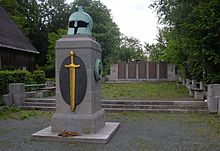Chemnitz-Grüna
|
Grüna district and statistical district No. 95 of Chemnitz |
|
|---|---|
| Coordinates | 50 ° 48 '45 " N , 12 ° 47' 40" E |
| surface | 13.86 km² |
| Residents | 5419 (Dec. 31, 2013) |
| Population density | 391 inhabitants / km² |
| Incorporation | Jan. 1, 1999 |
| Post Code | 09224 |
| prefix | 0371 |
| Transport links | |
| Highway |
|
Grüna is the largest district of Chemnitz in Saxony in terms of area . It was incorporated on January 1, 1999.
geography
Grüna is located west of downtown Chemnitz . It can still be seen today as an independent settlement area in the past. The northern part is entirely taken up by the Rabenstein Forest - the A4 motorway runs through it . Grüna is bordered by the districts of Pleißa and Känders von Limbach-Oberfrohna in the north, the Wüstenbrand district of Hohenstein-Ernstthal in the west , the Langenberg district of the Callenberg community and the city of Oberlungwitz , and the Chemnitz districts of Mittelbach , Reichenbrand , Rabenstein and Röhrsdorf in the south and east .
history
Grüna emerged in the 12th century as a two-row Waldhufendorf and as a monastery village belonged to the Chemnitz Benedictine Abbey and partly to the Rabenstein rule until 1375 . It was first mentioned in a document as "Gruna" in 1263. Grüna, which was divided into imperial knights and monasteries, was subordinated to the Chemnitz office after the dissolution of the Chemnitz monastery - the monastery part became the property of the Electors of Saxony . With the formation of the community Grüna in 1839, this division of the village was ended. In the 18th century, the stocking and glove knitting industry gave rise to an economic boom, which in the 19th century developed the community into an industrial and residential community. The upswing was facilitated by the Dresden – Werdau railway line, which opened in 1858 . In the 19th century, several shafts were sunk in Grüna in search of hard coal (including the “persistence shaft” on the Hexenberg). But they did not find anything, or the dismantling was not worthwhile.
The incorporation to Chemnitz took place on January 1st, 1999.
Memorials
- War memorial with a memorial to the people of Grüna who fell in World War I next to the Kreuz church on Chemnitzer Strasse
- Memorial stone in the yard of the former school at the Chemnitzer road for two unknown Jewish women inmates of a death march from the central warehouse in Christian town of Gross-Rosen concentration camp , in April 1945 by SS men were killed
Attractions
- Maria Josepha Tower on the Dead Stone
Personalities
Sons and daughters of the place
- Wilhelm August Seim (1844–1905), builder and politician ( National Liberal Party ), member of the state parliament
- Wolfgang Rauchfuß (1931–2005), GDR politician
- Johannes Dickert (* 1953), cantor and organist, canon of St. Mary's Cathedral in Wurzen
Worked in Grüna
- Georg Baumgarten (1837–1884), inventor, airship pioneer
- Fritz Hehle (* 1942), Saxon politician ( CDU )
- Peter Simmel (* 1959), German retailer
Companies
traffic
The breakpoint Grüna (Sachs) Hp is due to the Dresden-Werdau railway . Furthermore, the Grüna (Sachs) station was on the Küchwald – Obergrüna railway line and the Limbach – Wüstenbrand railway line .
literature
- Grüna . In: August Schumann : Complete State, Post and Newspaper Lexicon of Saxony. 3rd volume. Schumann, Zwickau 1816, p. 591.
- The district of Chemnitz in historical views. Geiger Verlag Horb am Neckar, 1992, ISBN 3-89264-730-5 (on the history of the places in the former district of Chemnitz : Grüner S. 94-103)
Individual evidence
Web links
- Grüna in the Digital Historical Directory of Saxony
- Information page for the village of Grüna
- Grüna at Chemnitzgeschichte.de






